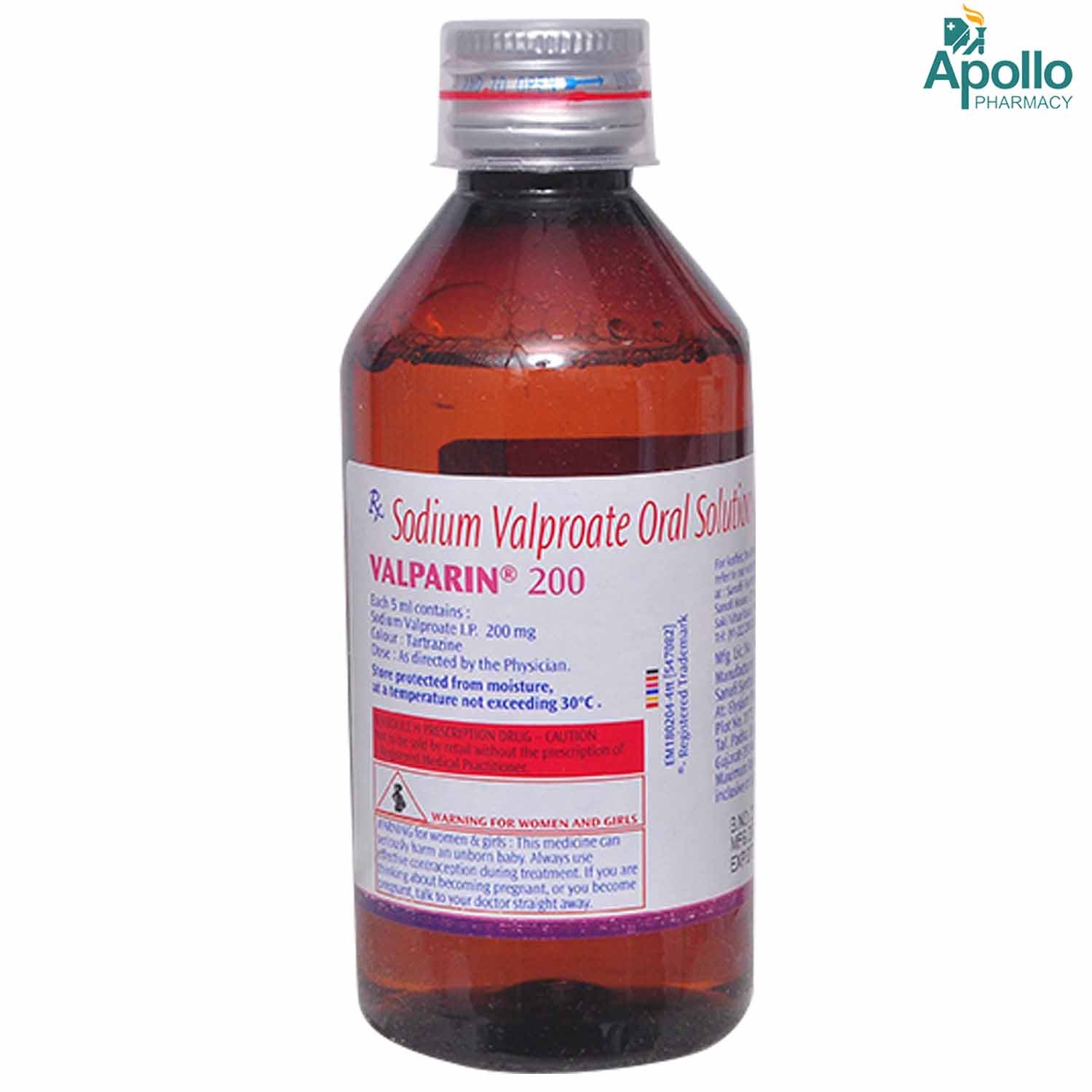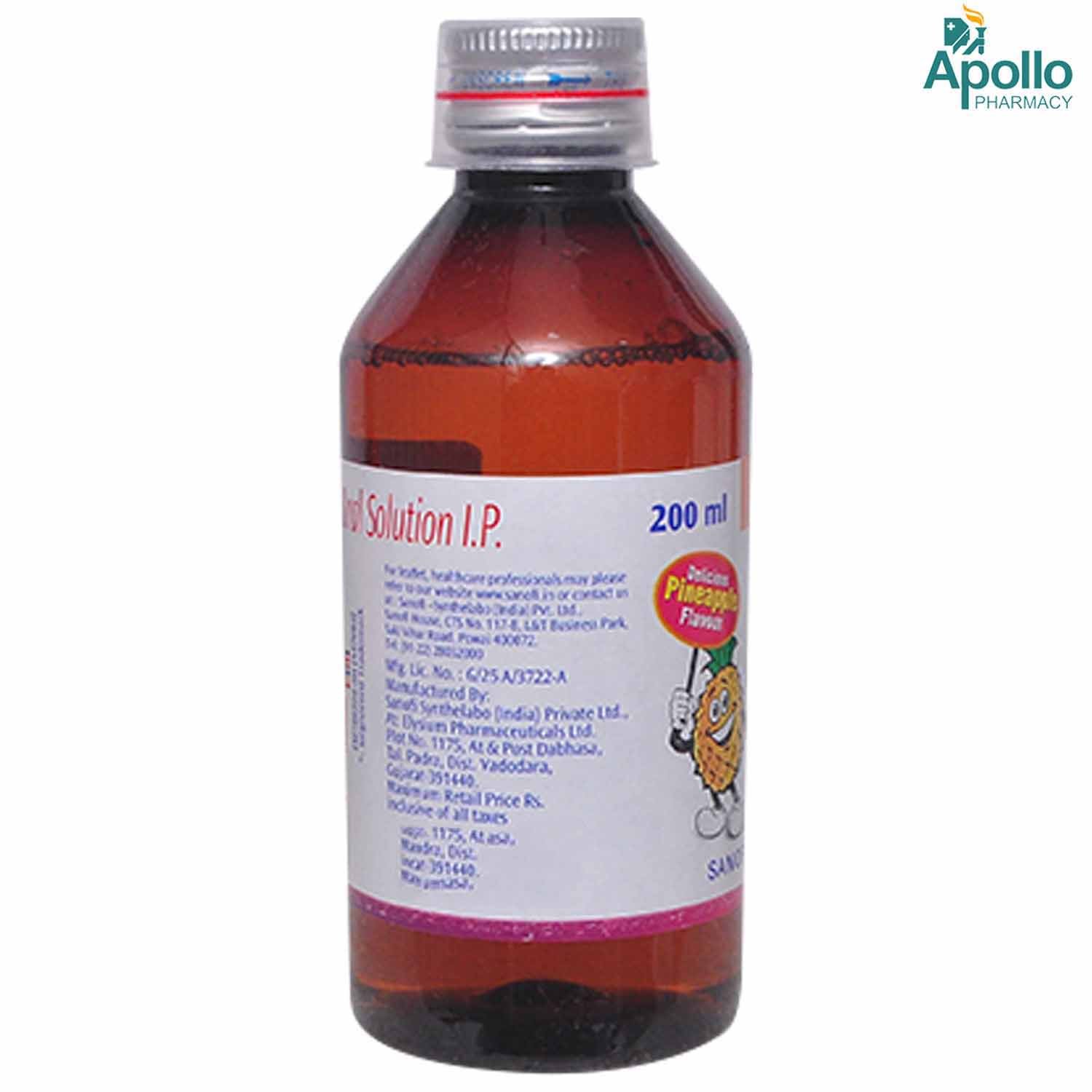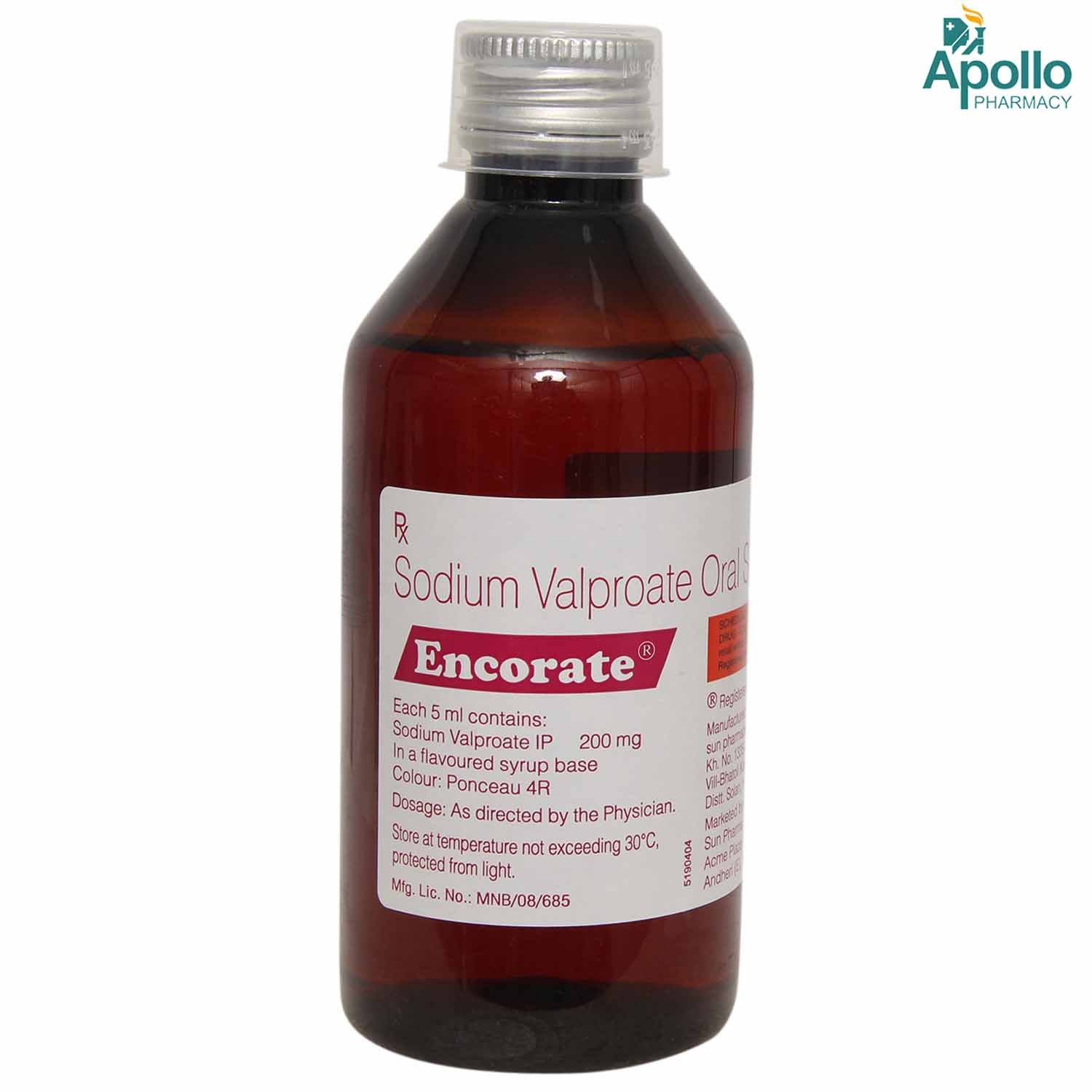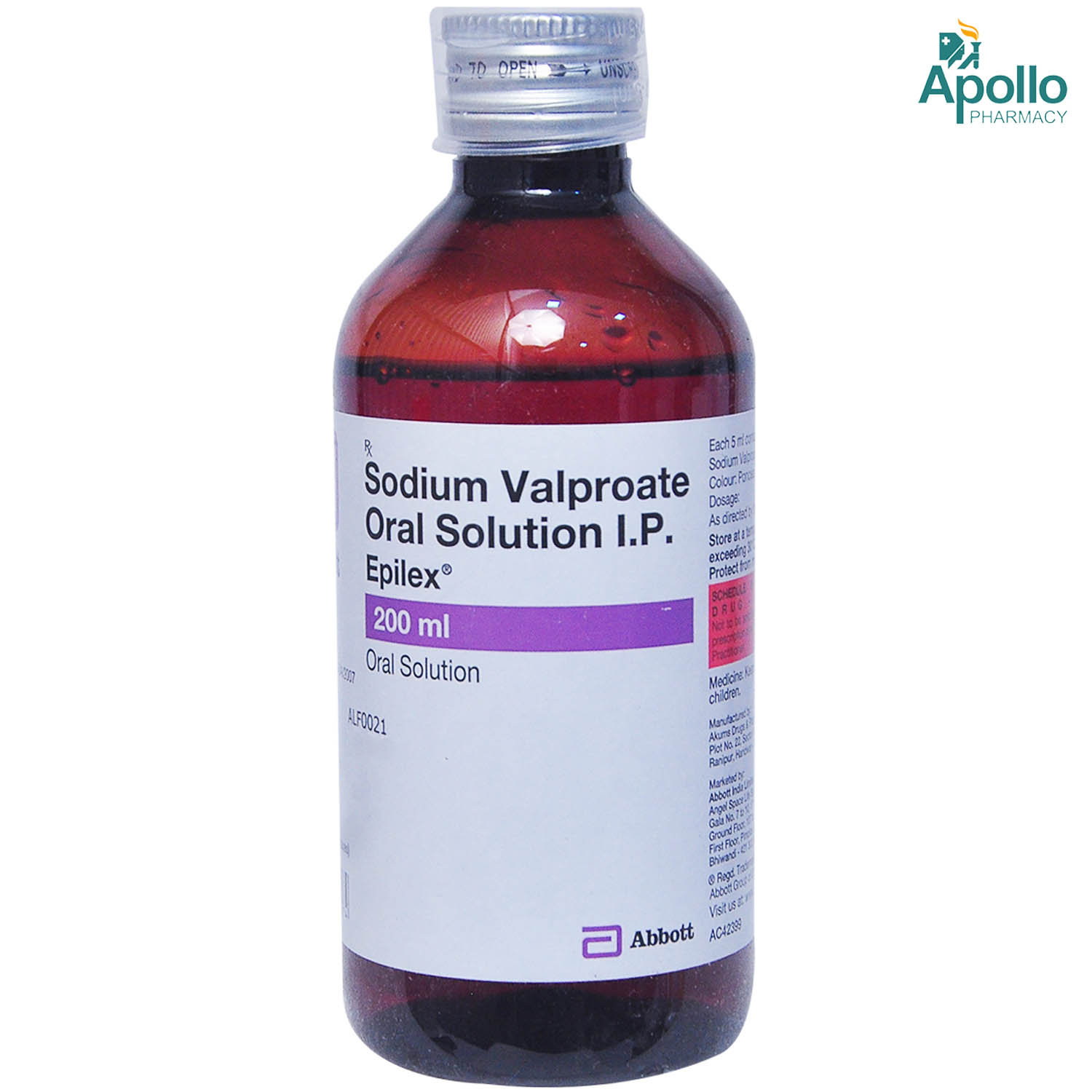Valparin 200 Delicious Pineapple Oral Solution 200 ml




MRP ₹145.5
(Inclusive of all Taxes)
₹21.8 Cashback (15%)
Selected Pack Size:200 ml
200 ml ₹130.95
(₹0.65 / 1 ml)
Out of stock
100 ml ₹130.95
(₹1.31 / 1 ml)
Out of stock
Provide Delivery Location
Online payment accepted
 Prescription drug
Prescription drugWhats That
Synonym :
Composition :
Manufacturer/Marketer :
Consume Type :
Return Policy :
Expires on or after :
NPPA :
About Valparin 200 Delicious Pineapple Oral Solution
Valparin 200 Delicious Pineapple Oral Solution belongs to the group of medicines called anticonvulsants or anti-epileptics used to treat epilepsy/seizures/fits and bipolar disorder. Epilepsy is a sudden rush of electricity in the brain. In epilepsy, the brain's electrical rhythms become imbalanced, resulting in recurrent seizures, sometimes leading to an unconscious state.
Valparin 200 Delicious Pineapple Oral Solution contains 'Sodium valproate', which decreases the brain's excessive and abnormal nerve activity. Thus, it helps in controlling seizures. Valparin 200 Delicious Pineapple Oral Solution increases the amount of a chemical substance called GABA; this helps block nerve transmission across the brain and provides a calming effect. Thus, it helps treat bipolar disorder.
Use Valparin 200 Delicious Pineapple Oral Solution as prescribed by your doctor. Sometimes, it may cause certain side effects such as stomach pain, nausea, vomiting, dry mouth, tremors, tiredness, sleepiness, headache, weight gain, and hair loss. Most of these side effects do not require medical attention and will resolve gradually. However, if the side effects persist or worsen, inform your doctor immediately.
Before using Valparin 200 Delicious Pineapple Oral Solution , inform your doctor about your children's medical conditions, sensitivities, and all medications used. To treat your condition effectually, continue using Valparin 200 Delicious Pineapple Oral Solution for as long as your doctor has prescribed. Valparin 200 Delicious Pineapple Oral Solution should be gradually withdrawn, so please do not stop using Valparin 200 Delicious Pineapple Oral Solution without consulting your doctor. Consult your doctor immediately if you observe any suicidal tendencies in your children.
Uses of Valparin 200 Delicious Pineapple Oral Solution
Directions for Use
Medicinal Benefits
Sodium valproate reduces the brain's excessive and unusual nerve activity. On the other hand, it helps to raise the quantity of a chemical substance called GABA in the brain, which helps to stop nerve transmission and has a calming effect. Thus, it aids in the treatment of epilepsy, seizures, and fits, as well as bipolar disorder.
Storage
- Inform your doctor about the nausea and discuss possible alternatives to the medication or adjustments to the dosage.
- Divide your daily food intake into smaller, more frequent meals to reduce nausea.
- Opt for bland, easily digestible foods like crackers, toast, plain rice, bananas, and applesauce.
- Avoid certain foods that can trigger nausea, such as fatty, greasy, spicy, and smelly foods.
- Drink plenty of fluids, such as water, clear broth, or electrolyte-rich beverages like coconut water or sports drinks.
- Use ginger (tea, ale, or candies) to help relieve nausea.
- Get adequate rest and also avoid strenuous activities that can worsen nausea.
- Talk to your doctor about taking anti-nausea medication if your nausea is severe.
- Record when your nausea occurs, what triggers it, and what provides relief to help you identify patterns and manage your symptoms more effectively.
- Consume controlled amounts of salt to raise sodium levels.
- Eat fresh fruits like apples, berries, oranges, mangoes, and bananas.
- Include fresh vegetables like broccoli, sweet potatoes, beets, okra, spinach, peppers, carrots, and edamame.
- Choose frozen vegetables without added butter or sauce.
- Drink electrolyte beverages like sports drinks or electrolyte solutions to replenish sodium and other electrolytes.
- Avoid excessive salt intake, but allow for controlled increases as needed.
- Monitor and manage underlying health conditions that may contribute to hyponatremia.
- Preventing Vomiting (Before it Happens)
- Take medication exactly as prescribed by your doctor. This can help minimize side effects, including vomiting.
- Having a small meal before taking your medication can help reduce nausea and vomiting.
- Talk to your doctor about taking anti-nausea medication along with your prescribed medication.
- Managing Vomiting (If it Happens)
- Try taking ginger in the form of tea, ale, or candy to help alleviate nausea and vomiting.
- What to Do if Vomiting Persists
- Consult your doctor if vomiting continues or worsens, consult the doctor for guidance on adjusting your medication or additional treatment.
- Brush and floss regularly twice a day with fluoride toothpaste and once a day with floss.
- Use a soft or extra-soft toothbrush.
- Avoid tobacco products, as smoking can worsen gum problems.
- Use an antimicrobial mouthwash to reduce bacteria and prevent bleeding.
- Drink green tea rich in catechin to reduce inflammation from oral bacteria.
- Eat a balanced diet high in nutrients and low in sugar.
- Reduce stress to minimize inflammation and gum bleeding.
- Consult your dentist if gums bleed consistently.
- Inform Your Doctor: Notify your doctor immediately about your diarrhoea symptoms. This allows them to adjust your medication or provide guidance on managing side effects.
- Stay Hydrated: Drink plenty of fluids to replace lost water and electrolytes. Choose water, clear broth, and electrolyte-rich drinks. Avoid carbonated or caffeinated beverages to effectively rehydrate your body.
- Follow a Bland Diet: Eat easy-to-digest foods to help firm up your stool and settle your stomach. Try incorporating bananas, rice, applesauce, toast, plain crackers, and boiled vegetables into your diet.
- Avoid Trigger Foods: Steer clear of foods that can worsen diarrhoea, such as spicy, fatty, or greasy foods, high-fibre foods, and dairy products (especially if you're lactose intolerant).
- Practice Good Hygiene: Maintain good hygiene to prevent the spread of infection. To stay healthy, wash your hands frequently, clean and disinfect surfaces regularly, and avoid exchanging personal belongings with others.
- Take Anti-Diarrheal Medications: If your doctor advises, anti-diarrheal medications such as loperamide might help manage diarrhoea symptoms. Always follow your doctor's directions.
- Keep track of your diarrhoea symptoms. If they don't get better or worse or are accompanied by severe stomach pain, blood, or dehydration signs (like extreme thirst or dark urine), seek medical help.
- Notify your doctor immediately if you experience tremors or involuntary shaking after taking medication or adjusting your medication regimen.
- Your doctor may adjust your medication regimen or recommend alternative techniques like relaxation, meditation, or journaling to alleviate tremor symptoms.
- Your doctor may direct you to practice stress-reducing techniques, such as deep breathing exercises, yoga, or journaling.
- Regular physical activity, such as walking or jogging, can help reduce anxiety and alleviate tremor symptoms.
- Your doctor may recommend lifestyle changes, such as avoiding caffeine, getting enough sleep, and staying hydrated, to help manage tremors.
- Maintain regular follow-up appointments with your doctor to monitor tremor symptoms and adjust treatment plans as needed.
Drug Warnings
The presence of other medical problems or using other medications may affect the use of this medicine. So, before using Valparin 200 Delicious Pineapple Oral Solution , let your doctor know about all your children's medical conditions, sensitivities, and all medications used. Do not use this medication on your own unless prescribed by the doctor. Do not exceed the stated recommended dose.
Drug-Drug Interactions
Drug-Drug Interactions
Login/Sign Up
Combining Sodium phenylbutyrate and Valparin 200 Delicious Pineapple Oral Solution 200 ml can increase ammonia levels in the blood.
How to manage the interaction:
Taking Sodium phenylbutyrate with Valparin 200 Delicious Pineapple Oral Solution 200 ml is not recommended, but it can be taken if prescribed by a doctor. If you experience any symptoms like sudden dizziness, lightheadedness, fainting, headache, shortness of breath, nausea, vomiting, chest pain or tightness, rapid heartbeat, or memory loss, contact your doctor immediately. Do not discontinue any medications without consulting a doctor.
Co-administration of Teriflunomide and Valparin 200 Delicious Pineapple Oral Solution 200 ml can increase the risk of causing liver problems.
How to manage the interaction:
Co-administration of Teriflunomide and Valparin 200 Delicious Pineapple Oral Solution 200 ml can lead to an interaction, it can be taken if advised by your doctor. However, if you experience any symptoms like fever, chills, joint pain or swelling, unusual bleeding or bruising, skin rash, itching, loss of appetite, fatigue, nausea, vomiting, abdominal pain, dark-colored urine, light-colored stools, and yellowing of the skin or eyes. Avoid alcohol while taking these medications, and consult your doctor immediately. Do not discontinue any medications without consulting your doctor.
Co-administration of Lithium with Valparin 200 Delicious Pineapple Oral Solution 200 ml can increase the risk irregular heart rhythm.
How to manage the interaction:
Co-administration of Lithium and Valparin 200 Delicious Pineapple Oral Solution 200 ml can lead to an interaction, but it can be taken if advised by your doctor. However, consult your doctor immediately if you experience any symptoms like dizziness, drowsiness, confusion, lightheadedness, fainting, shortness of breath, chest pain or tightness, rapid heartbeat, and difficulty concentrating. Do not discontinue any medications without consulting a doctor.
Co-administration of Valparin 200 Delicious Pineapple Oral Solution 200 ml with doripenem can reduce the blood levels of valproic acid.
How to manage the interaction:
Co-administration of Doripenam and Valparin 200 Delicious Pineapple Oral Solution 200 ml can lead to an interaction, it can be taken if advised by your doctor. However, if you experience sudden dizziness, lightheadedness, fainting, shortness of breath, chest pain or tightness, rapid heartbeat, involuntary muscle movements, or memory loss, contact your doctor immediately. Do not discontinue any medications without consulting a doctor.
Co-administration of Leflunomide and Valparin 200 Delicious Pineapple Oral Solution 200 ml can increase the risk of causing liver problems.
How to manage the interaction:
Co-administration of Leflunomide and Valparin 200 Delicious Pineapple Oral Solution 200 ml can lead to an interaction, they can be taken together if prescribed by a doctor. However, if you experience fever, chills, joint pain or swelling, unusual bleeding or bruising, skin rash, itching, less desire to eat, fatigue, nausea, vomiting, abdominal pain, or yellowing of the skin or eyes, contact a doctor immediately. Do not discontinue any medications without consulting a doctor.
The combined use of Ertapenem and Valparin 200 Delicious Pineapple Oral Solution 200 ml can reduce the blood levels of valproic acid.
How to manage the interaction:
Co-administration of Ertapenem and Valparin 200 Delicious Pineapple Oral Solution 200 ml can lead to an interaction, it can be taken if advised by your doctor. However, if you experience any symptoms like loss of seizure control or changes in behavior, consult your doctor immediately. Do not discontinue any medications without consulting the doctor.
Co-administration of Ketamine and Valparin 200 Delicious Pineapple Oral Solution 200 ml can increase side effects and cause respiratory depression.
How to manage the interaction:
Co-administration of Ketamine and Valparin 200 Delicious Pineapple Oral Solution 200 ml can lead to an interaction, but it can be taken if your doctor advises. However, consult your doctor immediately if you experience any symptoms like dizziness, drowsiness, confusion, difficulty concentrating, excessive sedation, impaired thinking, judgment, and motor coordination. Avoid driving or operating hazardous machinery until you know how these medications affect you. Do not discontinue any medications without consulting the doctor.
Co-administration of Meropenam and Valparin 200 Delicious Pineapple Oral Solution 200 ml together can reduce the effect of Valparin 200 Delicious Pineapple Oral Solution 200 ml.
How to manage the interaction:
Co-administration of Meropenam and Valparin 200 Delicious Pineapple Oral Solution 200 ml can lead to an interaction, but it can be taken if your doctor advises. However, if you experience any unusual symptoms, consult a doctor immediately. Do not discontinue any medications without consulting a doctor.
Co-administration of Vorinostat with Valparin 200 Delicious Pineapple Oral Solution 200 ml can increase the risk of unusual bleeding.
How to manage the interaction:
Co-administration of Vorinostat and Valparin 200 Delicious Pineapple Oral Solution 200 ml can lead to an interaction, it can be taken if advised by your doctor. However, if you experience any symptoms like unusual bleeding or bruising, vomiting, blood in your urine or stools, headache, dizziness, or weakness, consult your doctor immediately. Do not discontinue any medications without consulting your doctor.
Using buprenorphine together with Valparin 200 Delicious Pineapple Oral Solution 200 ml may increase the risk of severe side effects, including respiratory problems and loss of consciousness.
How to manage the interaction:
Although the administration of buprenorphine alongside Valparin 200 Delicious Pineapple Oral Solution 200 ml can result in an interaction, it can be taken if a doctor has advised it. However, if you experience sudden dizziness, lightheadedness, fainting, shortness of breath, chest pain or tightness, rapid heartbeat, or memory loss, contact a doctor immediately. Do not discontinue any medications without consulting a doctor.
Drug-Food Interactions
Drug-Food Interactions
Login/Sign Up
Diet & Lifestyle Advise
- A ketogenic diet (low in carbohydrates and high in fats) is recommended for children with epilepsy. This diet helps utilise fat instead of glucose for energy generation.
- Have a seizure response plan, and help those around you know what to do.
- Prepare your children's living area; small changes may reduce the risk of physical injury during a seizure.
- Understand what triggers seizures are and try reducing or avoiding them.
- Install an alarm or emergency device to get assistance during a seizure attack.
- Let your child rest well and sleep well.
Side Effects of Valparin 200 Delicious Pineapple Oral Solution
- Feeling or being sick
- Feeling tired or sleepy
- Stomach pain
- Diarrhoea
- Dry or sore mouth
- Swollen gums
- Shakes (tremors) in a part of your body
- Unusual eye movements
- Headache
- Weight gain
Habit Forming
Therapeutic Class
All Substitutes & Brand Comparisons
RX
Out of StockEpiford Oral Solution
Leeford Healthcare Ltd
₹64.9
(₹0.58/ 1ml)
10% CHEAPERRX
Encorate Oral Solution 200 ml
Sun Pharmaceutical Industries Ltd
₹138.5
(₹0.62/ 1ml)
4% CHEAPERRX
Epilex Oral Solution 200 ml
Abbott India Ltd
₹138.5
(₹0.62/ 1ml)
4% CHEAPER
Product Substitutes
Author Details
We provide you with authentic, trustworthy and relevant information
Drug-Diseases Interactions
Drug-Diseases Interactions
Login/Sign Up
FAQs
Valparin 200 Delicious Pineapple Oral Solution decreases the excessive and abnormal nerve activity in the brain. It balances the brain's chemical messenger and prevents overactivity of the brain, thereby controlling seizure episodes.
Valparin 200 Delicious Pineapple Oral Solution helps to treat manic episodes associated with bipolar disorder by increasing the amount of a chemical substance called GABA; this helps block nerve transmission across the brain and provides a calming effect.
Do not discontinue Valparin 200 Delicious Pineapple Oral Solution without consulting your doctor. To treat your child's condition effectually, continue using Valparin 200 Delicious Pineapple Oral Solution for as long as prescribed. Do not be reluctant to speak with your doctor if your child experiences difficulty while taking Valparin 200 Delicious Pineapple Oral Solution ; your doctor will gradually reduce the dose to avoid worsening seizures.
Valparin 200 Delicious Pineapple Oral Solution may change the results of liver enzymes and urine and blood tests. Inform the person doing the tests that your child using Valparin 200 Delicious Pineapple Oral Solution .
Drug-Drug Interactions Checker List
- ASPIRIN
- PHENOBARBITAL
- PRIMIDONE
- PHENYTOIN
- CARBAMAZEPINE
- TOPIRAMATE
- ACETAZOLAMIDE
- LAMOTRIGINE
- FELBAMATE
- WARFARIN
- ZIDOVUDINE
- LOPINAVIR
- RITONAVIR
- MOCLOBEMIDE
- SELEGILINE
- LINEZOLID
- AMITRIPTYLINE
- SERTRALINE
- QUETIAPINE
- OLANZAPINE
- RISPERIDONE
- NIMODIPINE
- PROPOFOL
- OESTROGEN
- LEVONORGESTREL
- MEFLOQUINE
- CHLOROQUINE
- CIMETIDINE
- IMIPENEM
- MEROPENEM
- RIFAMPICIN
- ERYTHROMYCIN
- CHOLESTYRAMINE
- CLONAZEPAM
- DIAZEPAM
Special Advise
Maintain all scheduled follow-up appointments with your healthcare practitioner.
Disease/Condition Glossary
Epilepsy: Epilepsy is a sudden rush of electricity in the brain. It is a nervous system disorder that occurs due to disturbed nerve cell activity in the brain. In epilepsy, the brain's electrical rhythms become imbalanced, resulting in recurrent seizures. In patients with seizures, the typical brain electrical pattern is disrupted by sudden bursts of electrical impulses that affect an individual's consciousness, movements or sensations. Seizures are of two types: generalized and partial seizures. Generalized seizures affect the entire brain, whereas partial seizures affect only a part of the brain. Seizures can cause uncontrollable muscle twitches and spasms. Stronger seizures may cause people to become confused or unconscious. Possible causes include high fever, trauma, genetic disorder, brain injury or stroke.
Bipolar disorder: Bipolar disorder, also known as manic depression or bipolar disease, is a mental health disorder associated with episodes of mood swings ranging from manic highs to depressive lows.

Have a query?
Buy best C.n.s Drugs products by
Intas Pharmaceuticals Ltd
Sun Pharmaceutical Industries Ltd
Torrent Pharmaceuticals Ltd
Alkem Laboratories Ltd
Abbott India Ltd
Cipla Ltd
Alteus Biogenics Pvt Ltd
Micro Labs Ltd
Lupin Ltd
Ipca Laboratories Ltd
D D Pharmaceuticals Pvt Ltd
Icon Life Sciences
Mankind Pharma Pvt Ltd
Tripada Healthcare Pvt Ltd
Arinna Lifesciences Ltd
Linux Laboratories Pvt Ltd
East West Pharma India Pvt Ltd
La Renon Healthcare Pvt Ltd
Talent India Pvt Ltd
Tas Med India Pvt Ltd
Zydus Healthcare Ltd
Cnx Health Care Pvt Ltd
Eris Life Sciences Ltd
Leeford Healthcare Ltd
Emcure Pharmaceuticals Ltd
Macleods Pharmaceuticals Ltd
Sigmund Promedica
Aristo Pharmaceuticals Pvt Ltd
Dr Reddy's Laboratories Ltd
Troikaa Pharmaceuticals Ltd
Consern Pharma Ltd
Zydus Cadila
Shine Pharmaceuticals Ltd
Wockhardt Ltd
Ardent Life Sciences Pvt Ltd
Crescent Formulations Pvt Ltd
Theo Pharma Pvt Ltd
Reliance Formulation Pvt Ltd
Ikon Pharmaceuticals Pvt Ltd
Propel Healthcare
Neon Laboratories Ltd
Jagsam Pharma
Msn Laboratories Pvt Ltd
Morepen Laboratories Ltd
Pulse Pharmaceuticals
Sanofi India Ltd
Med Manor Organics Pvt Ltd
Hetero Healthcare Pvt Ltd
Novartis India Ltd
Crescent Therapeutics Ltd
Elder Pharmaceuticals Ltd
Solvate Laboratories Pvt Ltd
Akumentis Healthcare Ltd
Mova Pharmaceutical Pvt Ltd
Psyco Remedies Ltd
Tripada Lifecare Pvt Ltd
Ajanta Pharma Ltd
Cyrus Remedies Pvt Ltd
Medishri Healthcare Pvt Ltd
Cadila Healthcare Ltd
Glenmark Pharmaceuticals Ltd
Matteo Health Care Pvt Ltd
Hbc Life Sciences Pvt Ltd
Lyf Healthcare
Matias Healthcare Pvt Ltd
Mesmer Pharmaceuticals
Alembic Pharmaceuticals Ltd
Capital Pharma
Crescent Pharmaceuticals
Medopharm Pvt Ltd
Alniche Life Sciences Pvt Ltd
Kivi Labs Ltd
Talin Remedies Pvt Ltd
USV Pvt Ltd
Quince Lifesciences Pvt Ltd
Solis Pharmaceuticals
Infivis Life Care
Zuventus Healthcare Ltd
Cadila Pharmaceuticals Ltd
Pfizer Ltd
Wallace Pharmaceuticals Pvt Ltd
A N Pharmacia Laboratories Pvt Ltd
Blue Cross Laboratories Pvt Ltd
Jenburkt Pharmaceuticals Ltd
Lia Life Sciences Pvt Ltd
Mano Pharma
Medley Pharmaceuticals Ltd
Primus Remedies Pvt Ltd
FDC Ltd
Maneesh Pharmaceuticals Ltd
Apex Laboratories Pvt Ltd
Gagnant Healthcare Pvt Ltd
Ozone Pharmaceuticals Ltd
RPG Life Sciences Ltd
Strides Shasun Ltd
Unichem International
GlaxoSmithKline Pharmaceuticals Ltd
Kuresys Labs Pvt Ltd
LA Pharma
Trion Pharma India Llp
Alcohol
Not applicable
It is intended for Children.
Pregnancy
Not applicable
It is intended for Children.
Breast Feeding
Not applicable
It is intended for Children.
Driving
Not applicable
It is intended for Children.
Liver
Caution
Inform your doctor if your child has liver problems. Your doctor will prescribe only if the benefits outweigh the risks.
Kidney
Caution
Inform your doctor if your child has kidney problems. Your doctor will prescribe only if the benefits outweigh the risks.
Children
Safe if prescribed
Valparin 200 Delicious Pineapple Oral Solution can be given safely to children. Give this medicine to your child in the doses as prescribed by the doctor.








